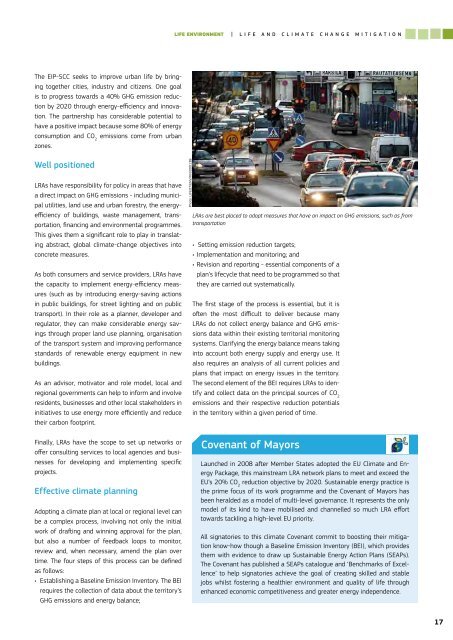Create successful ePaper yourself
Turn your PDF publications into a flip-book with our unique Google optimized e-Paper software.
LIFE ENVIRONMENT |LIFE and Climate CHANGE mitigationThe EIP-SCC seeks to improve urban life by bringingtogether cities, industry and citizens. One goalis to progress towards a 40% GHG emission reductionby 2020 through energy-efficiency and innovation.The partnership has considerable potential tohave a positive impact because some 80% of energyconsumption and CO 2emissions come from urbanzones.Well positionedLRAs have responsibility for policy in areas that havea direct impact on GHG emissions - including municipalutilities, land use and urban forestry, the energyefficiencyof buildings, waste management, transportation,financing and environmental programmes.This gives them a significant role to play in translatingabstract, global climate-change objectives intoconcrete measures.As both consumers and service providers, LRAs havethe capacity to implement energy-efficiency measures(such as by introducing energy-saving actionsin public buildings, for street lighting and on publictransport). In their role as a planner, developer andregulator, they can make considerable energy savingsthrough proper land use planning, organisationof the transport system and improving performancestandards of renewable energy equipment in newbuildings.As an advisor, motivator and role model, local andregional governments can help to inform and involveresidents, businesses and other local stakeholders ininitiatives to use energy more efficiently and reducetheir carbon footprint.Finally, LRAs have the scope to set up networks oroffer consulting services to local agencies and businessesfor developing and implementing specificprojects.Effective climate planningAdopting a climate plan at local or regional level canbe a complex process, involving not only the initialwork of drafting and winning approval for the plan,but also a number of feedback loops to monitor,review and, when necessary, amend the plan overtime. The four steps of this process can be definedas follows:• Establishing a Baseline Emission Inventory. The BEIrequires the collection of data about the territory’sGHG emissions and energy balance;Photo: LIFE07/ENV/FIN/000138LRAs are best placed to adopt measures that have an impact on GHG emissions, such as fromtransportation• Setting emission reduction targets;• Implementation and monitoring; and• Revision and reporting - essential components of aplan’s lifecycle that need to be programmed so thatthey are carried out systematically.The first stage of the process is essential, but it isoften the most difficult to deliver because manyLRAs do not collect energy balance and GHG emissionsdata within their existing territorial monitoringsystems. Clarifying the energy balance means takinginto account both energy supply and energy use. Italso requires an analysis of all current policies andplans that impact on energy issues in the territory.The second element of the BEI requires LRAs to identifyand collect data on the principal sources of CO 2emissions and their respective reduction potentialsin the territory within a given period of time.Covenant of MayorsLaunched in 2008 after Member States adopted the EU Climate and EnergyPackage, this mainstream LRA network plans to meet and exceed theEU’s 20% CO 2reduction objective by 2020. Sustainable energy practice isthe prime focus of its work programme and the Covenant of Mayors hasbeen heralded as a model of multi-level governance. It represents the onlymodel of its kind to have mobilised and channelled so much LRA efforttowards tackling a high-level EU priority.All signatories to this climate Covenant commit to boosting their mitigationknow-how though a Baseline Emission Inventory (BEI), which providesthem with evidence to draw up Sustainable Energy Action Plans (SEAPs).The Covenant has published a SEAPs catalogue and ‘Benchmarks of Excellence’to help signatories achieve the goal of creating skilled and stablejobs whilst fostering a healthier environment and quality of life throughenhanced economic competitiveness and greater energy independence.17


